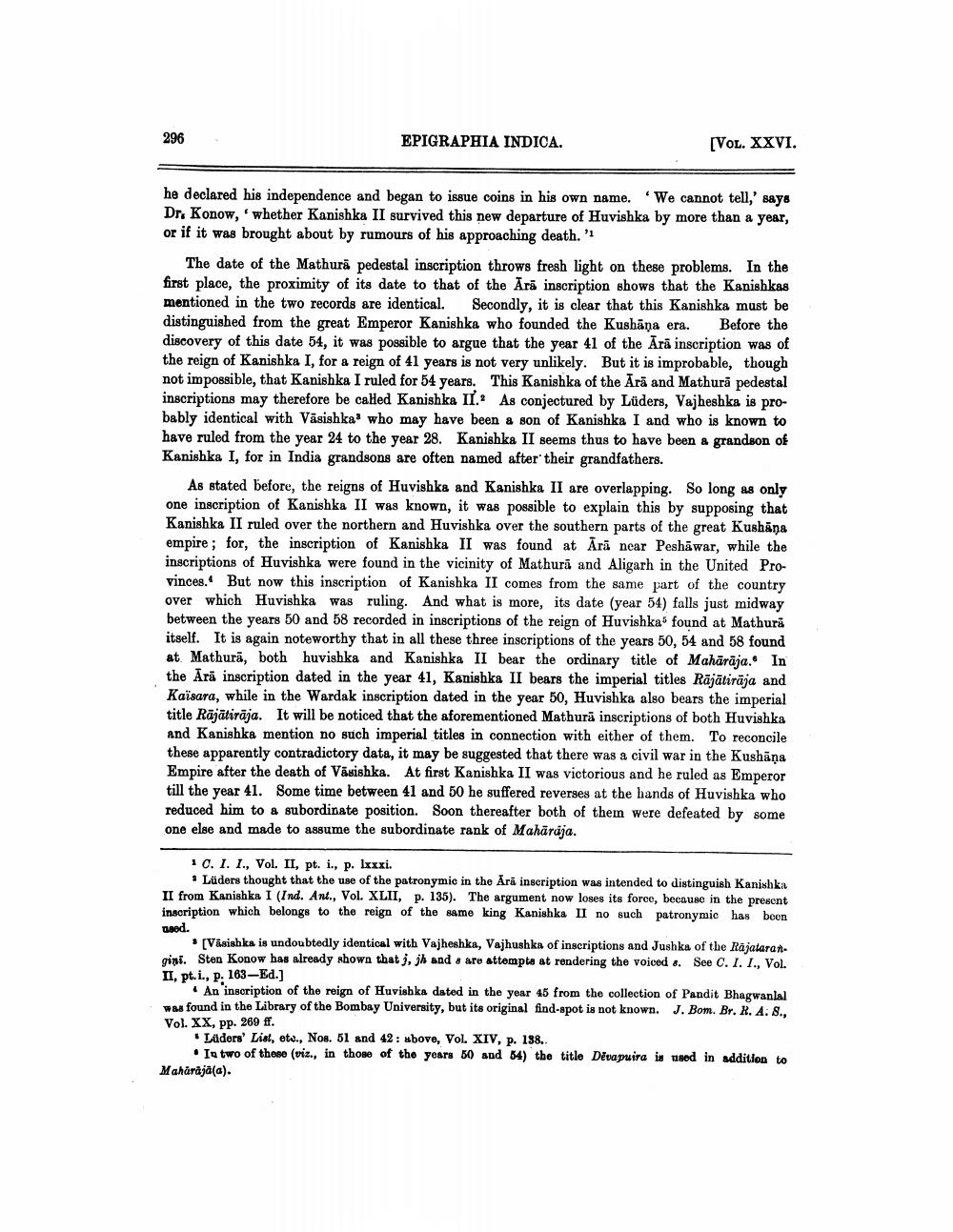________________
296
EPIGRAPHIA INDICA.
(VOL. XXVI.
he declared his independence and began to issue coins in his own name. We cannot tell,' says Dr. Konow, 'whether Kanishka II survived this new departure of Huvishka by more than a year, or if it was brought about by rumours of his approaching death.''
The date of the Mathurā pedestal inscription throws fresh light on these problems. In the first place, the proximity of its date to that of the Arā inscription shows that the Kanishkas mentioned in the two records are identical. Secondly, it is clear that this Kanishka must be distinguished from the great Emperor Kanishka who founded the Kushāna era. Before the discovery of this date 54, it was possible to argue that the year 41 of the Ārā inscription was of the reign of Kanishka I, for a reign of 41 years is not very unlikely. But it is improbable, though not impossible, that Kanishka I ruled for 54 years. This Kanishka of the Āra and Mathura pedestal inscriptions may therefore be caled Kanishka II. As conjectured by Lüders, Vajheshka is probably identical with Väsishkawho may have been a son of Kanishka I and who is known to have ruled from the year 24 to the year 28. Kanishka II seems thus to have been a grandson of Kanishka I, for in India grandsons are often named after their grandfathers.
As stated before, the reigns of Huvishka and Kanishka II are overlapping. So long as only one inscription of Kanishka II was known, it was possible to explain this by supposing that Kanishka II ruled over the northern and Huvishka over the southern parts of the great Kushāna empire ; for, the inscription of Kanishka II was found at Arā near Peshawar, while the inscriptions of Huvishka were found in the vicinity of Mathuri and Aligarh in the United Provinces. But now this inscription of Kanishka II comes from the same part of the country over which Huvishka was ruling. And what is more, its date (year 54) falls just midway between the years 50 and 58 recorded in inscriptions of the reign of Huvishkafound at Mathura itself. It is again noteworthy that in all these three inscriptions of the years 50, 54 and 58 found at Mathura. both huvishka and Kanishka II bear the ordinary title of Mahārāja. In the Ārā inscription dated in the year 41, Kanishka II bears the imperial titles Rājātirāja and Kaïsara, while in the Wardak inscription dated in the year 50, Huvishka also bears the imperial title Rājātirāja. It will be noticed that the aforementioned Mathura inscriptions of both Huvishka and Kanishka mention no such imperial titles in connection with either of them. To reconcile these apparently contradictory data, it may be suggested that there was a civil war in the Kushāņa Empire after the death of Väsishka. At first Kanishka II was victorious and he ruled as Emperor till the year 41. Some time between 41 and 50 he suffered reverses at the hands of Huvishka who reduced him to a subordinate position. Soon thereafter both of them were defeated by some one else and made to assume the subordinate rank of Maharaja.
10. I. I., Vol. II, pt. i., p. lxxxi.
· Lüders thought that the use of the patronymic in the Ara inscription was intended to distinguish Kanishka II from Kanishka I (Ind. Ant., Vol. XLII, p. 135). The argument now loses its force, because in the present inscription which belongs to the reign of the same king Kanishka II no such patronymic has been waed.
Vasishka is undoubtedly identical with Vajheshka, Vajhushkn of inscriptions and Jushka of the Rajalaran. gini. Sten Konow has already shown that j, jh and 8 are attempts at rendering the voiced s. See C. I. I., Vol. II, pt. i., p. 163-Ed.]
4 An inscription of the reign of Huvisbka dated in the year 45 from the collection of Pandit Bhagwanlal w found in the Library of the Bombay University, but its original find-spot is not known. J. Bom. Br. R. A. 8., Vol. XX, pp. 269 ff.
• Laders' List, etc., Nos. 51 and 42: above, Vol. XIV, p. 138.
. In two of these (viz., in those of the years 50 and 54) the title Dévapuira is used in addition to Maharaja(a).




